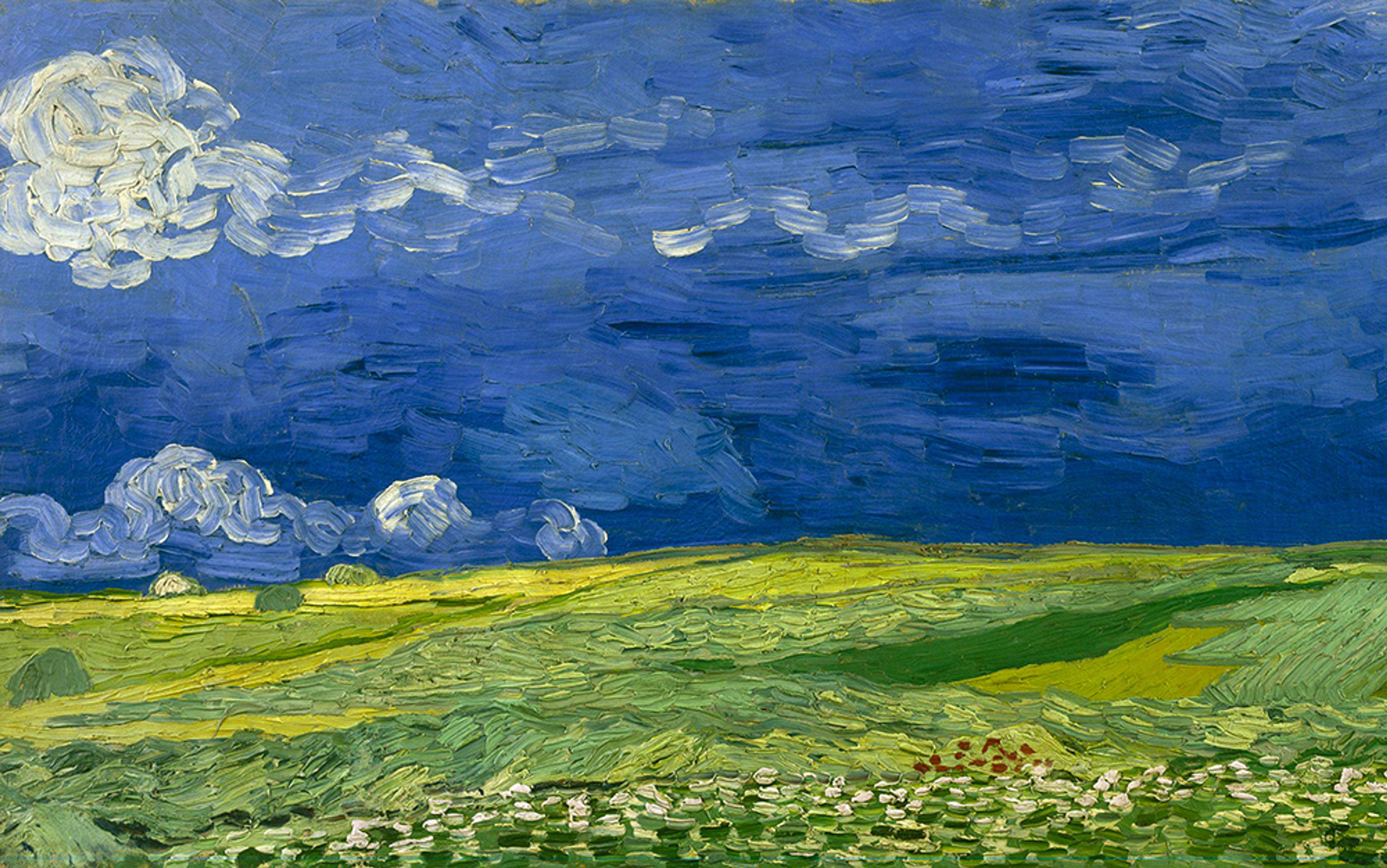Materialism holds the high ground these days in debates over that most ultimate of scientific questions: the nature of consciousness. When tackling the problem of mind and brain, many prominent researchers advocate for a universe fully reducible to matter. ‘Of course you are nothing but the activity of your neurons,’ they proclaim. That position seems reasonable and sober in light of neuroscience’s advances, with brilliant images of brains lighting up like Christmas trees while test subjects eat apples, watch movies or dream. And aren’t all the underlying physical laws already known?
From this seemly hard-nosed vantage, the problem of consciousness seems to be just one of wiring, as the American physicist Michio Kaku argued in The Future of the Mind (2014). In the very public version of the debate over consciousness, those who advocate that understanding the mind might require something other than a ‘nothing but matter’ position are often painted as victims of wishful thinking, imprecise reasoning or, worst of all, an adherence to a mystical ‘woo’.
It’s hard not to feel the intuitional weight of today’s metaphysical sobriety. Like Pickett’s Charge up the hill at Gettysburg, who wants to argue with the superior position of those armed with ever more precise fMRIs, EEGs and the other material artefacts of the materialist position? There is, however, a significant weakness hiding in the imposing-looking materialist redoubt. It is as simple as it is undeniable: after more than a century of profound explorations into the subatomic world, our best theory for how matter behaves still tells us very little about what matter is. Materialists appeal to physics to explain the mind, but in modern physics the particles that make up a brain remain, in many ways, as mysterious as consciousness itself.
When I was a young physics student I once asked a professor: ‘What’s an electron?’ His answer stunned me. ‘An electron,’ he said, ‘is that to which we attribute the properties of the electron.’ That vague, circular response was a long way from the dream that drove me into physics, a dream of theories that perfectly described reality. Like almost every student over the past 100 years, I was shocked by quantum mechanics, the physics of the micro-world. In place of a clear vision of little bits of matter that explain all the big things around us, quantum physics gives us a powerful yet seemly paradoxical calculus. With its emphasis on probability waves, essential uncertainties and experimenters disturbing the reality they seek to measure, quantum mechanics made imagining the stuff of the world as classical bits of matter (or miniature billiard balls) all but impossible.
Like most physicists, I learned how to ignore the weirdness of quantum physics. ‘Shut up and calculate!’ (the dictum of the American physicist David Mermin) works fine if you are trying to get 100 per cent on your Advanced Quantum Theory homework or building a laser. But behind quantum mechanics’ unequaled calculational precision lie profound, stubbornly persistent questions about what those quantum rules imply about the nature of reality – including our place in it.
Those questions are well-known in the physics community, but perhaps our habit of shutting up has been a little too successful. A century of agnosticism about the true nature of matter hasn’t found its way deeply enough into other fields, where materialism still appears to be the most sensible way of dealing with the world and, most of all, with the mind. Some neuroscientists think that they’re being precise and grounded by holding tightly to materialist credentials. Molecular biologists, geneticists, and many other types of researchers – as well as the nonscientist public – have been similarly drawn to materialism’s seeming finality. But this conviction is out of step with what we physicists know about the material world – or rather, what we don’t know.
Albert Einstein and Max Planck introduced the idea of the quantum at the beginning of the 20th century, sweeping away the old classical view of reality. We have never managed to come up with a definitive new reality to take its place. The interpretation of quantum physics remains as up for grabs as ever. As a mathematical description of solar cells and digital circuits, quantum mechanics works just fine. But if one wants to apply the materialist position to a concept as subtle and profound as consciousness, something more must clearly be asked for. The closer you look, the more it appears that the materialist (or ‘physicalist’) position is not the safe harbor of metaphysical sobriety that many desire.
For physicists, the ambiguity over matter boils down to what we call the measurement problem, and its relationship to an entity known as the wave function. Back in the good old days of Newtonian physics, the behaviour of particles was determined by a straightforward mathematical law that reads F = ma. You applied a force F to a particle of mass m, and the particle moved with acceleration a. It was easy to picture this in your head. Particle? Check. Force? Check. Acceleration? Yup. Off you go.
The equation F = ma gave you two things that matter most to the Newtonian picture of the world: a particle’s location and its velocity. This is what physicists call a particle’s state. Newton’s laws gave you the particle’s state for any time and to any precision you need. If the state of every particle is described by such a simple equation, and if large systems are just big combinations of particles, then the whole world should behave in a fully predictable way. Many materialists still carry the baggage of that old classical picture. It’s why physics is still widely regarded as the ultimate source of answers to questions about the world, both outside and inside our heads.
In Isaac Newton’s physics, position and velocity were indeed clearly defined and clearly imagined properties of a particle. Measurements of the particle’s state changed nothing in principle. The equation F = ma was true whether you were looking at the particle or not. All of that fell apart as scientists began probing at the scale of atoms early last century. In a burst of creativity, physicists devised a new set of rules known as quantum mechanics. A critical piece of the new physics was embodied in Schrödinger’s equation. Like Newton’s F = ma, the Schrödinger equation represents mathematical machinery for doing physics; it describes how the state of a particle is changing. But to account for all the new phenomena physicists were finding (ones Newton knew nothing about), the Austrian physicist Erwin Schrödinger had to formulate a very different kind of equation.
When calculations are done with the Schrödinger equation, what’s left is not the Newtonian state of exact position and velocity. Instead, you get what is called the wave function (physicists refer to it as psi after the Greek symbol Ψ used to denote it). Unlike the Newtonian state, which can be clearly imagined in a commonsense way, the wave function is an epistemological and ontological mess. The wave function does not give you a specific measurement of location and velocity for a particle; it gives you only probabilities at the root level of reality. Psi appears to tell you that, at any moment, the particle has many positions and many velocities. In effect, the bits of matter from Newtonian physics are smeared out into sets of potentials or possibilities.
How can there be one rule for the objective world before a measurement is made, and another that jumps in after the measurement?
It’s not just position and velocity that get smeared out. The wave function treats all properties of the particle (electric charge, energy, spin, etc) the same way. They all become probabilities holding many possible values at the same time. Taken at face value, it’s as if the particle doesn’t have definite properties at all. This is what the German physicist Werner Heisenberg, one of the founders of quantum mechanics, meant when he advised people not to think of atoms as ‘things’. Even at this basic level, the quantum perspective adds a lot of blur to any materialist convictions of what the world is built from.
Then things get weirder still. According to the standard way of treating the quantum calculus, the act of making a measurement on the particle kills off all pieces of the wave function, except the one your instruments register. The wave function is said to collapse as all the smeared-out, potential positions or velocities vanish in the act of measurement. It’s like the Schrödinger equation, which does such a great job of describing the smeared-out particle before the measurement is made, suddenly gets a pink slip.
You can see how this throws a monkey wrench into a simple, physics-based view of an objective materialist world. How can there be one mathematical rule for the external objective world before a measurement is made, and another that jumps in after the measurement occurs? For a hundred years now, physicists and philosophers have been beating the crap out of each other (and themselves) trying to figure out how to interpret the wave function and its associated measurement problem. What exactly is quantum mechanics telling us about the world? What does the wave function describe? What really happens when a measurement occurs? Above all, what is matter?
There are today no definitive answers to these questions. There is not even a consensus about what the answers should look like. Rather, there are multiple interpretations of quantum theory, each of which corresponds to a very different way of regarding matter and everything made of it – which, of course, means everything. The earliest interpretation to gain force, the Copenhagen interpretation, is associated with Danish physicist Niels Bohr and other founders of quantum theory. In their view, it was meaningless to speak of the properties of atoms in-and-of-themselves. Quantum mechanics was a theory that spoke only to our knowledge of the world. The measurement problem associated with the Schrödinger equation highlighted this barrier between epistemology and ontology by making explicit the role of the observer (that is: us) in gaining knowledge.
Not all researchers were so willing to give up on the ideal of objective access to a perfectly objective world, however. Some pinned their hopes on the discovery of hidden variables – a set of deterministic rules lurking beneath the probabilities of quantum mechanics. Others took a more extreme view. In the many-worlds interpretation espoused by the American physicist Hugh Everett, the authority of the wave function and its governing Schrödinger equation was taken as absolute. Measurements didn’t suspend the equation or collapse the wave function, they merely made the Universe split off into many (perhaps infinite) parallel versions of itself. Thus, for every experimentalist who measures an electron over here, a parallel universe is created in which her parallel copy finds the electron over there. The many-worlds Interpretation is one that many materialists favor, but it comes with a steep price.
Here is an even more important point: as yet there is no way to experimentally distinguish between these widely varying interpretations. Which one you choose is mainly a matter of philosophical temperament. As the American theorist Christopher Fuchs puts it, on one side there are the psi-ontologists who want the wave function to describe the objective world ‘out there’. On the other side, there are the psi-epistemologists who see the wave function as a description of our knowledge and its limits. Right now, there is almost no way to settle the dispute scientifically (although a standard form of hidden variables does seem to have been ruled out).
This arbitrariness of deciding which interpretation to hold completely undermines the strict materialist position. The question here is not if some famous materialist’s choice of the many-worlds interpretation is the correct one, any more than whether the silliness of The Tao of Physics and its quantum Buddhism is correct. The real problem is that, in each case, proponents are free to single out one interpretation over others because … well … they like it. Everyone, on all sides, is in the same boat. There can be no appeal to the authority of ‘what quantum mechanics says’, because quantum mechanics doesn’t say much of anything with regard to its own interpretation.
Putting the perceiving subject back into physics seems to undermine the whole materialist perspective
Each interpretation of quantum mechanics has its own philosophical and scientific advantages, but they all come with their own price. One way or another, they force adherents to take a giant step away from the kind of ‘naive realism’, the vision of little bits of deterministic matter, that was possible with the Newtonian world view; switching to a quantum ‘fields’ view doesn’t solve the problem. It was easy to think that the mathematical objects involved with Newtonian mechanics referred to real things out there in some intuitive way. But those ascribing to psi-ontology – sometimes called wave function realism – must now navigate a labyrinth of challenges in holding their views. The Wave Function (2013), edited by the philosophers Alyssa Ney and David Z Albert, describes many of these options, which can get pretty weird. Reading through the dense analyses quickly dispels any hope that materialism offers a simple, concrete reference point for the problem of consciousness.
The attraction of the many-worlds interpretation, for instance, is its ability to keep the reality in the mathematical physics. In this view, yes, the wave function is real and, yes, it describes a world of matter that obeys mathematical rules, whether someone is watching or not. The price you pay for this position is an infinite number of parallel universes that are infinitely splitting off into an infinity of other parallel universes that then split off into … well, you get the picture. There is a big price to pay for the psi-epistemologist positions too. Physics from this perspective is no longer a description of the world in-and-of itself. Instead, it’s a description of the rules for our interaction with the world. As the American theorist Joseph Eberly says: ‘It’s not the electron’s wave function, it’s your wave function.’
A particularly cogent new version of the psi-epistemological position, called Quantum Bayesianism or QBism, raises this perspective to a higher level of specificity by taking the probabilities in quantum mechanics at face value. According to Fuchs, the leading proponent of QBism, the irreducible probabilities in quantum mechanics tell us that it’s really a theory about making bets on the world’s behaviour (via our measurements) and then updating our knowledge after those measurements are done. In this way, QBism points explicitly to our failure to include the observing subject that lies at the root of quantum weirdness. As Mermin wrote in the journal Nature: ‘QBism attributes the muddle at the foundations of quantum mechanics to our unacknowledged removal of the scientist from the science.’
Putting the perceiving subject back into physics would seem to undermine the whole materialist perspective. A theory of mind that depends on matter that depends on mind could not yield the solid ground so many materialists yearn for.
It is easy to see how we got here. Materialism is an attractive philosophy – at least, it was before quantum mechanics altered our thinking about matter. ‘I refute it thus,’ said the 18th-century writer Samuel Johnson kicking a large rock as refutation to arguments against materialism he’d just endured. Johnson’s stony drop-kick is the essence of a hard-headed (and broken-footed) materialist vision of the world. It provides an account of exactly what the world is made of: bits of stuff called matter. And since matter has properties that are independent and external to anything having to do with us, we can use that stuff to build a fully objective account of a fully objective world. This ball-and-stick vision of reality seems to inspire much of materialism’s public confidence about cracking the mystery of the human mind.
Today, though, it is hard to reconcile that confidence with the multiple interpretations of quantum mechanics. Newtonian mechanics might be fine for explaining the activity of the brain. It can handle things such as blood flow through capillaries and chemical diffusion across synapses, but the ground of materialism becomes far more shaky when we attempt to grapple with the more profound mystery of the mind, meaning the weirdness of being an experiencing subject. In this domain, there is no avoiding the scientific and philosophical complications that come with quantum mechanics.
First, the differences between the psi-ontological and psi-epistemological positions are so fundamental that, without knowing which one is correct, it’s impossible to know what quantum mechanics is intrinsically referring to. Imagine for a moment that something like the QBist interpretation of quantum mechanics were true. If this emphasis on the observing subject were the correct lesson to learn from quantum physics, then the perfect, objective access to the world that lies at the heart of materialism would lose a lot of wind. Put another way: if QBism or other Copenhagen-like views are correct, there could be enormous surprises waiting for us in our exploration of subject and object, and these would have to be included in any account of mind. On the other hand, old-school materialism – being a particular form of psi-ontology – would by necessity be blind to these kinds of additions.
A second and related point is that, in the absence of experimental evidence, we are left with an irreducible democracy of possibilities. At a 2011 quantum theory meeting, three researchers conducted just such a poll, asking participants: ‘What is your favourite interpretation of quantum mechanics?’ (Six different models got votes, along with some preferences for ‘other’ and ‘no preference’.) As useful as this exercise might be for gauging researchers’ inclinations, holding a referendum for which interpretation should become ‘official’ at the next meeting of the American Physical Society (or the American Philosophical Society) won’t get us any closer to the answers we seek. Nor will stomping our feet, making loud proclamations, or name-dropping our favourite Nobel-prizewinning physicists.
Rather than trying to sweep away the mystery of mind by attributing it to the mechanisms of matter, we must grapple with the intertwined nature of the two
Given these difficulties, one must ask why certain weird alternatives suggested by quantum interpretations are widely preferred over others within the research community. Why does the infinity of parallel universes in the many-worlds interpretation get associated with the sober, hard-nosed position, while including the perceiving subject gets condemned as crossing over to the shores of anti-science at best, or mysticism at worst?
It is in this sense that the unfinished business of quantum mechanics levels the playing field. The high ground of materialism deflates when followed to its quantum mechanical roots, because it then demands the acceptance of metaphysical possibilities that seem no more ‘reasonable’ than other alternatives. Some consciousness researchers might think that they are being hard-nosed and concrete when they appeal to the authority of physics. When pressed on this issue, though, we physicists are often left looking at our feet, smiling sheepishly and mumbling something about ‘it’s complicated’. We know that matter remains mysterious just as mind remains mysterious, and we don’t know what the connections between those mysteries should be. Classifying consciousness as a material problem is tantamount to saying that consciousness, too, remains fundamentally unexplained.
Rather than sweeping away the mystery of mind by attributing it to the mechanisms of matter, we can begin to move forward by acknowledging where the multiple interpretations of quantum mechanics leave us. It’s been more than 20 years since the Australian philosopher David Chalmers introduced the idea of a ‘hard problem of consciousness’. Following work by the American philosopher Thomas Nagel, Chalmers pointed to the vividness – the intrinsic presence – of the perceiving subject’s experience as a problem no explanatory account of consciousness seems capable of embracing. Chalmers’s position struck a nerve with many philosophers, articulating the sense that there was fundamentally something more occurring in consciousness than just computing with meat. But what is that ‘more’?
Some consciousness researchers see the hard problem as real but inherently unsolvable; others posit a range of options for its account. Those solutions include possibilities that overly project mind into matter. Consciousness might, for example, be an example of the emergence of a new entity in the Universe not contained in the laws of particles. There is also the more radical possibility that some rudimentary form of consciousness must be added to the list of things, such as mass or electric charge, that the world is built of. Regardless of the direction ‘more’ might take, the unresolved democracy of quantum interpretations means that our current understanding of matter alone is unlikely to explain the nature of mind. It seems just as likely that the opposite will be the case.
While the materialists might continue to wish for the high ground of sobriety and hard-headedness, they should remember the American poet Richard Wilbur’s warning:
Kick at the rock, Sam Johnson, break your bones:
But cloudy, cloudy is the stuff of stones.






